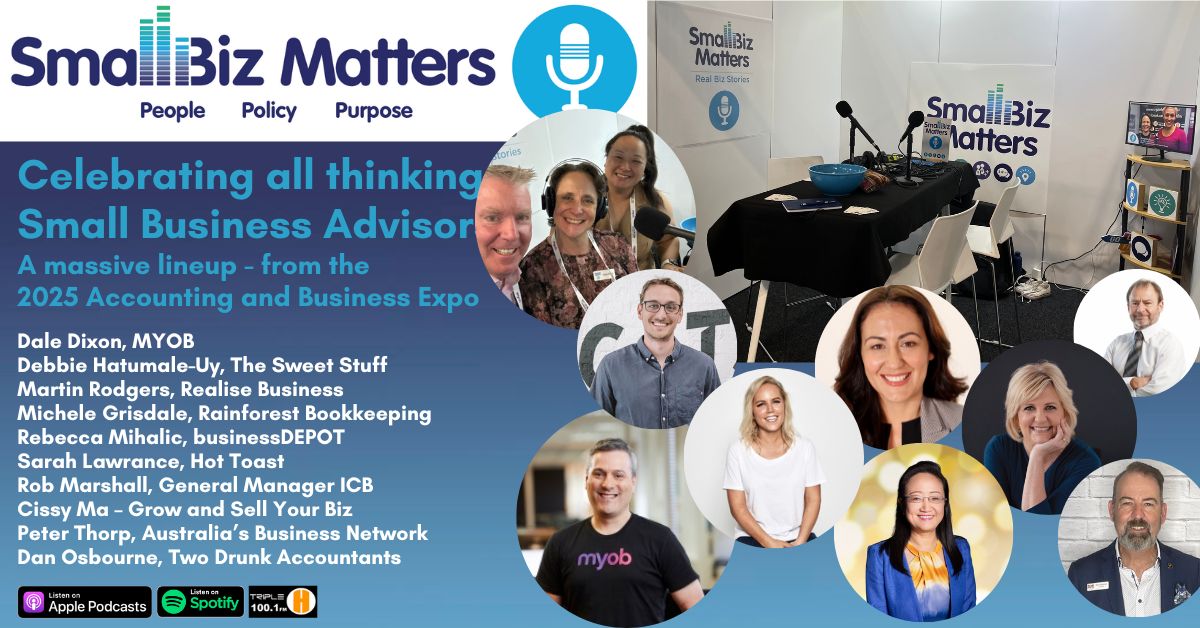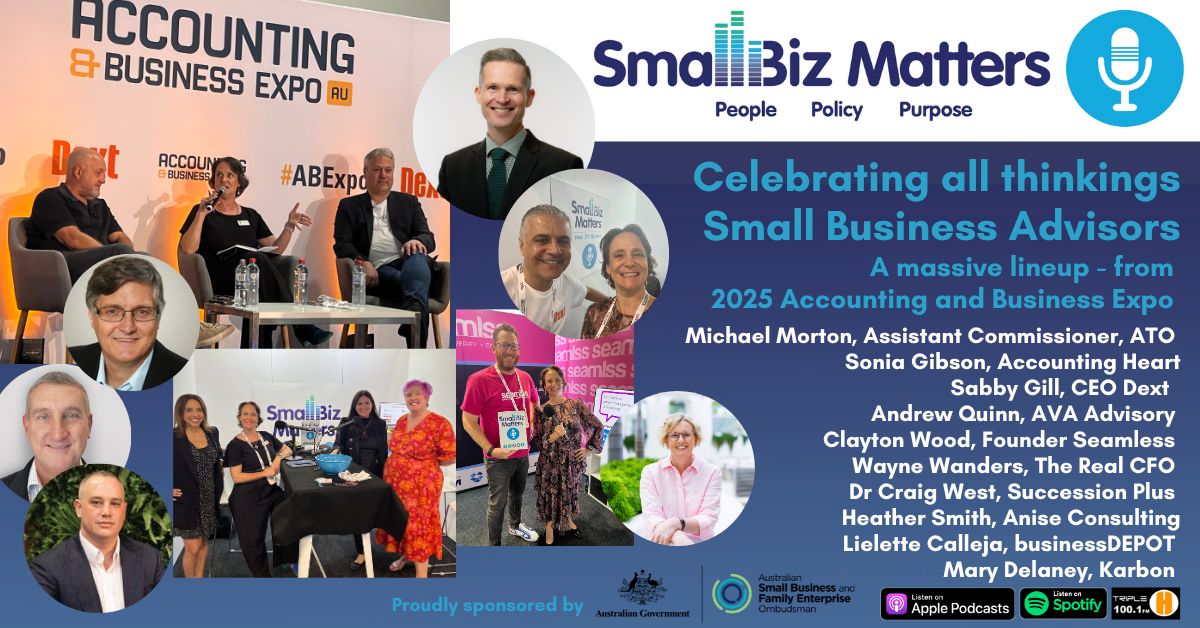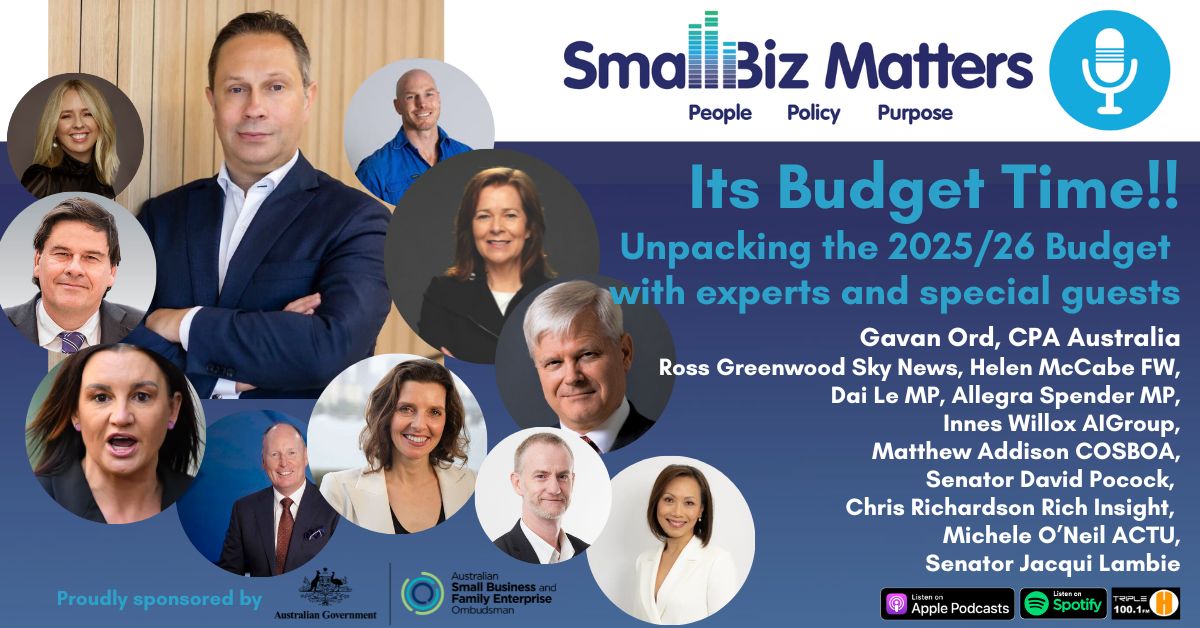Unpacking the GST
|Let me just start by stating this disclaimer that I am not an accountant and the following should not be taken as financial or taxation advice; listeners should ALWAYS seek the advice of a professional who specialises in taxation, if they have any questions relating to their business or indeed their personal affairs.
This show is based on client questions regarding GST which they put to me as a bookkeeper and an Admin Consultant at Boyd Office Management Services. In particular today we are talking to businesses just starting out who know little about the GST, how it works and how to implement it. But to be honest there is a lot of misunderstanding about this legislation in my experience with the small business community. Even experienced business owners who have owned a number of businesses still seem to get things wrong. And as usual on Small Biz Matters, we’re here to help.
Now, just to begin a quick note about last weeks’ show, where we talked about motivation and how to get back into the swing of things after a lovely holiday, but since one of the great motivators in business is money, we also touched on some great money saving tips leading up to NEXT Xmas but also some budgeting tips. If you missed it you can of course listen to the podcasts on my website via the Blogs and Podcasts page but also as promised we have uploaded the two budget planners we talked about last week. So a big thank you to the ladies in the Facebook Group – Mums on a Budget (find them on FB) and also Olivia Wilson at Steps Financial for giving us those great budget tools. You can find Steps financial online and also on Facebook.
Part 1 – Unpacking GST
(this info is all online at the ATO website)
- The GST is currently at 10% and is on most Goods AND Services in Australia
- Even if you’re not charging GST you need to make this clear to your customers on your invoices. Invoices over $82.50 need to show the following
- Your valid tax invoice should have the following:
- Under $1000 a valid tax invoice must:
- Have the words Tax Invoice on it
- supplier’s business/entity name
- the supplier’s ABN
- the date the invoice was issued
- a brief description of the items/services sold, including quantity (if applicable) and price
- the GST amount (if any) payable – this can be shown separately or, if the GST amount is exactly one-eleventh of the total price, as a statement such as 'Total price includes GST'
- If the suppliers does not collect GST it must show $0 for GST
- Over $1000 a valid tax invoice must have all of the above plus:
- the buyer’s business name & address
- the buyer’s ABN
- You become registered for GST with the ATO once your sales are over $75,000 in a financial year. Now a lot of people think once they approach $75k they need to start charging GST immediately that day. Tthe ATO is watching your income (as is your accountant) over a tax financial year and its ok to start charging GST when the next financial year starts but check this with your accountant.. It's a good idea to be aware of this as your income starts to approach $75k so you can make the transition at the start of a financial year. That keeps everything clean.
- Once you are registered for GST (and not before) you can claim the GST you pay (on valid cost of sales or expenses to do with running your business) OFF the GST liability you have to the ATO. You also have to submit a BAS which tells the ATO the GST you collected and the GST you paid. The difference between the two is what you pay the tax office.
- The reporting period is normally once every quarter (3 months) Keep a close eye on your reporting and due dates for your GST. It is VERY important that you pay & lodge your GST on time. The ATO treats a BAS debt the same way it would a Tax debt… very seriously and you need to keep on top of it. You can however apply for a payment plan (the ATO is surprisingly flexible on this topic) BUT you have to do it BEFORE the BAS is due so make sure you are organised and complete the BAS a few days in advance so if you can’t PAY it by the due date you have the change to apply for a payment plan. And remember once you have one payment plan in place for a BAS debt you can’t set another one up for another quarter’s BAS debt until that one is paid off completely. So save that option for the “big” ones.
- Your bookkeeper (registered with the Tax Practitioners Board) or accountant can register you for GST. You can also do it yourself by calling the ATO. You then get notified in writing when you are registered.
- You must register within 21 days of reaching the threshold. You may choose to register if your GST turnover is below the threshold.
- Contractors and the GST – you can easily find out if contractors should be charging GST or not and I would always check the ABN of a new contractor as well as whether they are registered for GST. You can do this on the business.gov.au ABN Lookup site. Very easy to use, you just type in the supplied ABN, or their name and it will tell you if they are registered for GST or not.
Typical questions
- GST on credit card surcharges that we charge our customers?
- Here is an example from the ATO website to answer this question:
- Anastasia is in a store and decides to purchase a shirt. The shirt's price tag indicates that the price is $55 (inclusive of GST). There is a sign at the counter indicating that a surcharge of 3% of the price will be imposed if payment is made by credit card.
- Anastasia decides to pay by credit card and the merchant imposes a surcharge of $1.65 in respect of the sale. The price payable in respect of the shirt is now $56.65. As the supply of the shirt is a taxable supply, the GST payable in respect of the sale is $5.15, being 1/11 of the GST inclusive price of $56.65.
- We sell our customers packing cartons (inc. GST) but then buy them back from our customers after they use them, (e.g. sell for $3.30 inc GST then buy back for $1.10)...so do we claim GST on the purchase when buying them back? In this scenario you can’t claim back the GST because the person you are buying those cartons BACK from are not registered for GST and aren’t supplying you with a tax invoice for them, BUT if you were to set up this transaction as a refund then the GST would be cancelled out
Part 2 – Some tips on how to implement GST properly
- Once you start charging GST it is always a good idea to start using an accounting software package which utilises GST. Xero, MYOB and Quickbooks are all excellent at tracking and helping you to report on GST.
- Some tips when setting up your accounts on this new software:
- As new contractors come on board with your business CHECK their ABN on the ABN lookup website and then as you enter their card for the first time in your accounts with the correct GST code and their ABN. If you get in the habit of this it will help in the long run.
- Also make sure they are supplying a VALID tax invoice every time. Make sure they correct it before you pay.
- Some bills don’t have GST in them – water for example and milk are both GST exempt items. Also, when you pay certain types of insurance there is an item called Stamp Duty which is GST exempt so make sure that line in your bill screen has the right GST code. A good way to check if you have the GST right is to compare your GST in your accounts against the GST on the bill you received.
- The ATO and many accountants also suggest you have a separate accounts where you put the GST so you have it ready to pay to the ATO when it is due.
(Photo courtesy of https://www.flickr.com/photos/sling_flickr/)





